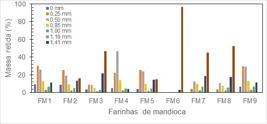Abstract
The northern region of Brazil is a large cassava producer, and cassava flour has been handcrafted and consumed daily by the local population. This study aimed to classify and characterize nine different samples of cassava flour marketed in Belém-PA/ Brazil from a nutritional and technological point of view. The results were subjected to analysis of variance and the averages were compared using the Scott Knott test (p < 0.05). The flours were within the legislation in relation to moisture and ash contents, with high acidity, four out of nine flours evaluated had cyanide content between 15 and 31 mg HCN/kg. Regarding color and particle size, samples varied between yellow (67%) and white (33%); from coarse (67%) to medium (33%), respectively. From a nutritional point of view, the cassava flours are a source of dietary fiber (7.67% to 11.26%) and raw starch, which have satiety benefits. From the technological point of view, the flours are used as thickeners, producing pastes that are clear with a long and less firm texture. These variations in nutritional and technological characteristics allowed to verify that changes in processing are necessary to standardize the quality of flours used as a gluten free food ingredient.
Keywords:
Manihot esculenta; Physicochemical properties; Toxic compounds; Carbohydrates; Paste properties; Gel strength

 Thumbnail
Thumbnail
 Thumbnail
Thumbnail
 Thumbnail
Thumbnail


